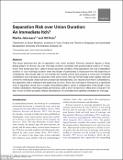Separation risk over union duration : an immediate itch?
Abstract
This study examines the risk of separation over union duration. Previous research reports a rising-falling pattern of divorce risk over marriage duration consistent with psychological notions of ‘honeymoon’ and ‘seven-year itch’. Little is known about the variation of the separation risk over cohabitation duration or over marriage duration when the length of partnership is measured from the beginning of coresidence. We include data on non-marital and marital unions and propose a novel way of treating cohabitation and marriage as episodes of the same union. We use Finnish large-scale register data and control for individuals’ observed and unobserved characteristics. Our results show that in cohabitations, the separation rate is highest at the beginning of union. Entry into marriage is followed by a significant drop in separation levels and a modest rising-falling pattern, which is independent of the length of premarital cohabitation. Clearly, the rising-falling pattern is robust but only part of a larger picture and reflects processes specific to marriage. Despite high prevalence of cohabitation, marrying entails more permanence, with some short ‘honeymoon’ effect and some long-term ‘effect’, much of which probably reflects self-selection of committed and satisfied cohabiters to marriage.
Citation
Jalovaara , M & Kulu , H 2018 , ' Separation risk over union duration : an immediate itch? ' , European Sociological Review , vol. 34 , no. 5 , pp. 486–500 . https://doi.org/10.1093/esr/jcy017
Publication
European Sociological Review
Status
Peer reviewed
ISSN
0266-7215Type
Journal article
Description
This work was supported by the Academy of Finland (decision number 275030).Collections
Items in the St Andrews Research Repository are protected by copyright, with all rights reserved, unless otherwise indicated.

